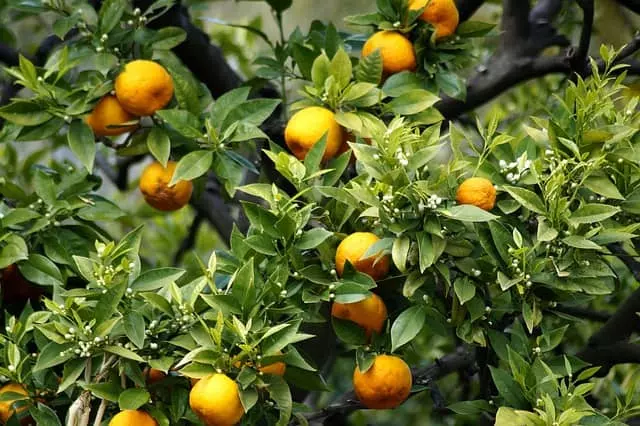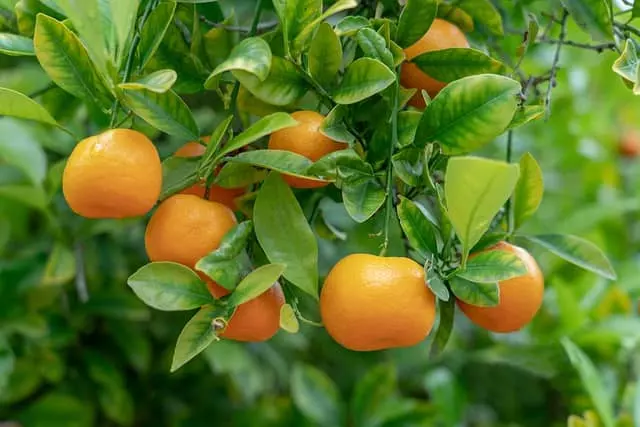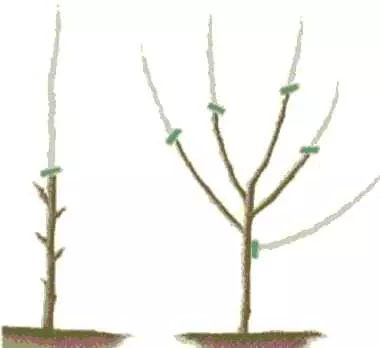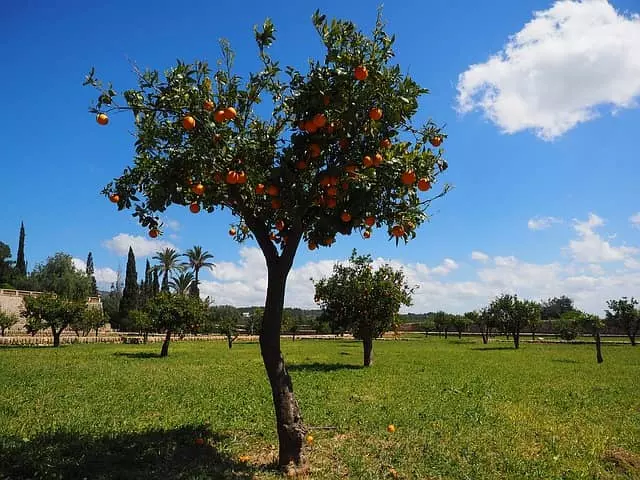The orange tree is a fruit tree of the genus Citrus, which is part of the Rutaceae family. It is an evergreen tree that in optimal growing conditions reaches up to 43 ft (13 m) in height. Its white flowers produce what makes this plant so popular, its fruit, the orange. This article on when and how to prune an orange tree could not be missing on this site, including brief tips on how to care for them.
Table of Contents
Orange Tree Care
Although in this post we will talk about orange tree pruning, it is a caring technique for this fruit tree. That is why we will start with some key tips to take care of your orange tree.
Location: when selecting the place where we will locate our orange tree, we must look for one with direct sunlight. This will ensure optimum growth and development.
Watering: it needs abundant water in the summer months. As a general rule, which will vary with the rainfall received, you can water 3 times a week in hot weather, and every 4-5 days during the rest of the year.
Fertilizer: the orange tree should be fertilized annually with organic elements. It should be rich in nitrogen, phosphorus, and potassium.
Leaves: the analysis of the leaves of this fruit tree often indicates its needs. For example, if they turn yellowish with green nerves, they may need iron sulfate. On the other hand, if they turn completely yellow, they may need zinc sulfate. If a green V remains on the yellowish leaf, it is most likely that our orange tree has a magnesium deficiency. It is therefore advisable to be attentive to any change in the leaves of the orange tree, and if in doubt consult an expert.
Temperature: areas with extremely low temperatures can kill the orange tree. If this is your case, you should cover the base with plastic as soon as the cold starts. If it is a small plant, and you have it in a pot, it is best to bring it indoors.
Repotting: if you have your orange tree in a pot, you should repot it in spring. Wait until the last frosts have passed before taking any risk. If you change pots, make sure that they drain properly.
Mulching: Mulching is a technique that consists of covering the surface of the soil where the crops are located with organic material, such as straw, leaves, and dry branches. Its objective is to protect the soil from the sun’s rays and, at the same time, to fertilize it through the decomposition of the organic elements that make up the mulch. This generates a microclimate that not only favors the soil but also helps maintain optimum humidity levels.

Tools For Pruning an Orange Tree
Several tools need to be used to prune an orange tree. The choice will depend largely on the type of pruning and the size of the fruit tree.
Pruning shears (Order here).
Pruning Saw (Order here).
Shears and saw for pruning at height (Order here).
Chainsaw. We recommend this chainsaw, which is the same one we use on our trees (Order here).
Ladders or scaffolding.
Basic safety equipment such as helmet and gloves.
It is advisable to disinfect the cutting tools before pruning. This will help to avoid transmitting diseases, you should do it before starting pruning and every time you change plants.
How to Prune an Orange Tree
The main principles for pruning an orange tree can be summarized as follows:
- To form a structure on which all the products should be supported.
- To distribute the production branches correctly, thus allowing good illumination and ventilation of the canopy.
- Ensure good production.
- Adapt the planting frame according to the size of the variety.
This will lead us to have a correctly formed and balanced fruit tree, something that allows:
- Facilitate lighting, ventilation, and entry of phytosanitary products in treatments.
- Achieve a correct distribution of fruit in the most suitable areas.
- Increase fruit size and color.
- To regulate production avoiding abundant or scarce years in flowering and fruiting (alternate years).
- Balance the relationship between vegetation and production organs.
- Eliminate diseased, dry, or unproductive branches, thus avoiding tree aging and the spread of pests and diseases.

Pruning Orange Trees According to Their Age
In short, when pruning an orange tree, the aim is to increase the profitability of a plantation. This implies a series of works focused in different ways according to the stage of the tree’s life.
1°. As soon as an orange tree is repotting it, the first pruning must begin, tending to give the first outlines of the future structure. This is known as PLANTATION PRUNING.
2º. In its first stage, the first years of planting, we must try to form a strong and vigorous framework, thinking of the harvest that it will support and that does not hinder the various cultivation operations. We will call it FORMATION PRUNING.
3º. In the following phase, a balance must be sought between vegetative and productive development. The operations that are carried out constitute the MAINTENANCE AND FRUCTIFICATION PRUNING, although it is not possible to establish boundaries between the previous stage and this one.
4º. Another phase is that in which, due to climatic accidents (frost), diseases, age, abandonment of unpruned trees, etc., it is necessary to intervene more energetically. The set of these actions, to recover the tree for normal production, will constitute the so-called RESTORATION OR REGENERATION PRUNING. Normally these more severe actions are used to make a change of variety or to make room in the framework of plantations.
Orange Tree Planting Pruning
This is the pruning of the orange tree that is carried out once it has been repotted. In it, we will eliminate part of the branches, especially the more tender ones. Normally the seedling should have a main branch with a height of more than 32″ (80 cm). which will be cut at about 24-28″ (60-70 cm) from the ground. In addition, the tender shoots that are less than 16″ (40 cm) from the ground should be removed.
The steps to follow should be:
1. Undo the clod of earth attached to the plant, even if it is potted, in water, in order not to damage the roots.
2. Check the state of the main roots and sanitize them (root pruning).
3. Plant the seedling in its final location, making sure that the roots are well arranged in the hole.
4. Cut the stem or aerial part at 24-28″ (60-70 cm), measured from the ground level, since the root is insufficient to resist the loss of humidity through the aerial part.
Young Orange Tree Pruning – Formation
This pruning of the orange tree is carried out in its first years of life. The objective is to create a structure of main branches capable of supporting its weight and that of the crop.
During the first years, pruning is limited to:
1. The removal of all shoots arising from the rootstock, up to a height of 16-24″ (40-60 cm) (protector).
2. The removal of one or more branches located in the center of the tree and which, due to their location, will not be main branches.

The main branches are selected during the 2nd and 4th year, from among those that have shown the greatest vigor and taking care to:
A) Choose a maximum of 3 to 4 branches.
B) That they are distributed equidistantly around the stem (if you select 4 main branches you can take the cardinal points as orientation).
C) That they contribute to giving solidity and consistency to the crown, avoiding that they emerge from the same height.
D) To facilitate access, avoid branches that are too high or too low.
Pruning An Adult Orange Tree – Maintenance
When pruning an orange tree in its adult stage, the aim is to correct the defects originated by the vegetative development of the tree and to maintain the pruning system chosen. We will also try to regulate production and favor illumination.
If we have carried out a correct pruning of the orange tree during its formation and we correct any defect in the vegetative development, the necessary pruning is minimal. It is limited to a simple thinning of branches.
Therefore, when we have our orange tree well-formed, all that remains is to maintain it with the following:
1. Remove dead, diseased, or very injured branches.
2. Cut branches that are badly directed and/or badly placed.
3- Respect the main structure.
4. Lift skirts to about 20″ (50 cm).
5. Thinning of branches.
6. Cut any offshoots that are in the center of the canopy.
7. Maintain a certain distance from nearby trees, at least 20″ (50 cm).
You must understand this pruning of the orange tree as a light pruning just to maintain the structure. It is not good to perform frequent heavy pruning on this fruit tree.

Pruning An Old Orange Tree – Restoration
When the orange tree is several years old and begins to reduce its number of fruits and its size, heavy pruning can be carried out to restore its vigor. This heavy pruning is known as rejuvenation or restoration pruning.
Such a strong pruning implies a great imbalance between the aerial and subway parts, and, therefore, it will be necessary to reduce fertilization, irrigation, etc., taking into account this imbalance, reducing, as much as possible, the flow of sap to the aerial part.
When To Prune an Orange Tree
To select the right time to prune an orange tree, the age of the tree has a lot to do with its age.
In young trees, training pruning can be done at any time, as long as there is no danger of low temperatures. To eliminate important branches, pruning should be done at times when vegetative activity is minimal.
In adult trees, pruning should be done after the risk of frost has passed and the fruit has been harvested. In the event of falling temperatures, pruned trees suffer more than those that have not yet been touched.
Since it is not always possible to prune when you want to, it is more advisable to delay pruning than to prune early. The danger of early pruning is more serious than that of late pruning.
As a last tip, I recommend that once all the cuts have been made, paint them with a cut cover. This will prevent the entry of possible diseases or pests, something very common in wounds as large as those generated with this pruning.
We hope that this article on how to prune the orange tree will be useful and will allow you to have your orange tree in the best conditions. We recommend our article yellow leaves on orange trees.

